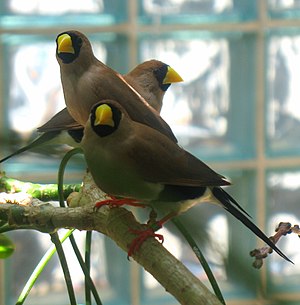Mask amadine
| Mask amadine | ||||||||||||
|---|---|---|---|---|---|---|---|---|---|---|---|---|

Masked amadine ( Poephila personata ) |
||||||||||||
| Systematics | ||||||||||||
|
||||||||||||
| Scientific name | ||||||||||||
| Poephila personata | ||||||||||||
| Gould , 1842 |
The masked finch ( Poephila personata ) is a bird art from the family of finches . Like all species of its genus of grass finches, it belongs to the fauna of Australia and occurs there in the northwest of the continent. To the south their distribution area extends to the 19th parallel .
description
Masked amadines reach a body length of up to 14 centimeters and are among the largest species of finch. Their bright yellow beak, which stands out clearly from the small, black face mask, is striking. The plumage on the chest, stomach, neck and upper wing is a light ocher. The tail feathers are black and white. Females and males have the same plumage. They can be most clearly distinguished by their vocalizations. The male's song is a plaintive, whistling chirping.
Distribution and way of life
The distribution area of the mask amadine is northern Australia from the extreme north of Western Australia to the Cape York Peninsula . They colonize dry steppe landscapes here and prefer eucalyptus forests near water points, which at the same time have a dense undergrowth of various shrubs and open grass areas strewn across. In contrast to the belt grass finch and the pointed-tailed amadine , the masked amadine is a somewhat stronger cultural follower . It is also found in the few settlements in Northern Australia. The main food is semi-ripe and ripe seeds of various steppe grasses. Masked amams are mostly on the ground to forage. They spend their breaks in tall, shady trees.
Masked amadines are buccaneers who build a ball nest in the bushes. They use plant fibers, grasses and moss for this. The female lays between four and six eggs. The incubation period is between 13 and 14 days.
Masked amadines are very sociable birds that prefer to breed with other conspecifics in loose colonies.
supporting documents
literature
- Horst Bielfeld : Knowing and caring for 300 ornamental birds. Ulmer Verlag, Stuttgart 2009, ISBN 978-3-8001-5737-2 .
- Jürgen Nicolai (Ed.), Joachim Steinbacher (Ed.), Renate van den Elzen, Gerhard Hofmann: Prachtfinken - Australia, Oceania, Southeast Asia. Eugen Ulmer Verlag, Stuttgart 2001, ISBN 3-8001-3249-4 .
- Peter Clement , Alan Harris , John Davis: Finches and Sparrows - An Identification Guide. Christopher Helm, London 1993, ISBN 0-7136-8017-2 .
Web links
- Poephila personata in the endangered Red List species the IUCN 2008. Posted by: BirdLife International, 2008. Accessed January 31 of 2009.